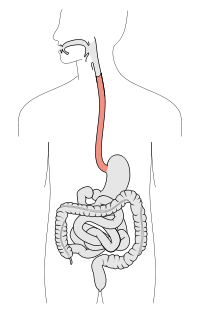
Photo from wikipedia
Little is known of the relationships among paediatric upper gastrointestinal microbiotas, and the impact of medication use and disease on their diversity. Here, we investigated the diversity of three microbiotas… Click to show full abstract
Little is known of the relationships among paediatric upper gastrointestinal microbiotas, and the impact of medication use and disease on their diversity. Here, we investigated the diversity of three microbiotas in the upper gastrointestinal tract of paediatric patients in relation to each other and to host factors. Oral, oesophageal and gastric microbiotas from a prospective paediatric cohort (n=54) were profiled using the 16S rRNA gene and ITS2 amplicon sequencing. 16S rRNA gene amplicon sequencing of oesophageal biopsies from a retrospective paediatric cohort (n=96) and shotgun metagenomics data from oesophageal brushings (n=88) were employed for genomic signature validation. Bacterial diversity and composition showed substantial differences across oral, oesophageal and gastric fluid samples that were not replicated for fungi, and the presence of reflux led to increased homogeneity in the bacterial component of these three microbiotas. The oral and oesophageal microbiotas were associated with age, sex, history of oesophageal atresia and presence of oesophageal metaplasia, with the latter characterized by Prevotella enrichment. Proton pump inhibitor use was associated with increased oral bacterial richness in the gastric fluid, and this correlated with increased levels of gastric pro-inflammatory cytokines. Profiling of oesophageal biopsies from a retrospective paediatric cohort confirmed an increased Prevotella prevalence in samples with metaplasia. Analysis of metagenome-derived oesophageal Prevotella melaninogenica genomes identified strain-specific features that were significantly increased in prevalence in samples with metaplasia. Prevotella enrichment is a signature associated with paediatric oesophageal metaplasia, and proton pump inhibitor use substantially alters the paediatric gastric microenvironment.
Journal Title: Microbial Genomics
Year Published: 2022
Link to full text (if available)
Share on Social Media: Sign Up to like & get
recommendations!